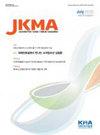Understanding colorectal polyps to prevent colorectal cancer
IF 0.3
Q3 MEDICINE, GENERAL & INTERNAL
引用次数: 0
Abstract
Background: Colorectal cancer (CRC) is one of the leading causes of cancer-related mortality worldwide. Most CRCs arise through carcinogenesis pathways from precancerous lesions, such as adenoma and sessile serrated lesions (SSLs). Understanding the characteristics of such precancerous colorectal polyps and the carcinogenesis pathways helps to develop CRC preventive strategies via screening, colonoscopic polypectomy, and surveillance.Current Concepts: Benign colorectal tumors can be classified as conventional adenomatous and serrated polyps. Conventional adenoma is one of the most prevalent precancerous polyps detected on screening colonoscopy, but most are small. Small colorectal adenomas are less likely to contain advanced histology, such as villous features, high-grade dysplasia, or invasive cancer. A small adenoma may progress slowly over 10 years to become an invasive cancer via the chromosomal instability pathway. SSL is a recently established precancerous lesion and is estimated to account for approximately 15% of sporadic CRC. Most SSLs are not dysplastic and progress very slowly through the serrated carcinogenesis pathway. Conversely, SSL with dysplasia (SSLD) may progress more rapidly, as a mismatch repair gene product is defective. According to colonoscopy studies, SSLD comprises only 4% to 8% of SSLs, with a prevalence of 0.1% to 0.9%. Most precancerous lesions detected on colonoscopy progress slowly to CRC and are appropriate targets for colonoscopic polypectomy for the prevention of CRC.Discussion and Conclusion: Colorectal adenoma and SSL are representative precancerous lesions of CRC and most are slow progressing enough to be detected and removed via colonoscopy before CRC development.了解结直肠息肉预防结直肠癌
背景:结直肠癌(CRC)是全球癌症相关死亡的主要原因之一。大多数恶性肿瘤是通过癌前病变(如腺瘤和无梗锯齿状病变(sls))的癌变途径发生的。了解这种癌前结肠息肉的特征和癌变途径有助于通过筛查、结肠镜息肉切除术和监测制定结直肠癌预防策略。当前观念:良性结直肠肿瘤可分为传统的腺瘤状息肉和锯齿状息肉。常规腺瘤是结肠镜检查中发现的最常见的癌前息肉之一,但大多数是小的。小的结直肠腺瘤不太可能包含高级组织学,如绒毛状特征、高度不典型增生或浸润性癌症。一个小的腺瘤可能在10年的时间里通过染色体不稳定性途径缓慢发展成为侵袭性癌症。SSL是最近发现的癌前病变,估计约占散发性结直肠癌的15%。大多数SSLs不是发育不良,通过锯齿状癌变途径进展非常缓慢。相反,SSL伴发育不良(SSLD)可能进展更快,因为错配修复基因产物有缺陷。根据结肠镜检查研究,sld仅占sld的4%至8%,患病率为0.1%至0.9%。大多数结肠镜检查发现的癌前病变进展缓慢,是结肠镜息肉切除术预防结直肠癌的合适目标。讨论与结论:结直肠腺瘤和SSL是结直肠癌的典型癌前病变,大多数进展缓慢,在结直肠癌发生前可通过结肠镜检查发现并切除。
本文章由计算机程序翻译,如有差异,请以英文原文为准。
求助全文
约1分钟内获得全文
求助全文
来源期刊

Journal of The Korean Medical Association
Medicine-General Medicine
CiteScore
0.50
自引率
0.00%
发文量
84
审稿时长
4-8 weeks
期刊介绍:
The Journal of the Korean Medical Association (JKMA) is the official peer-reviewed, open-access, monthly journal of the Korean Medical Association (KMA). It contains articles in Korean or English. Its abbreviated title is ''J Korean Med Assoc''. The aims of the Journal include contributing to the treatment of and preventing diseases of public health importance and to improvement of health and quality of life through sharing the state-of the-art scientific information on medicine by the members of KMA and other national and international societies.
 求助内容:
求助内容: 应助结果提醒方式:
应助结果提醒方式:


